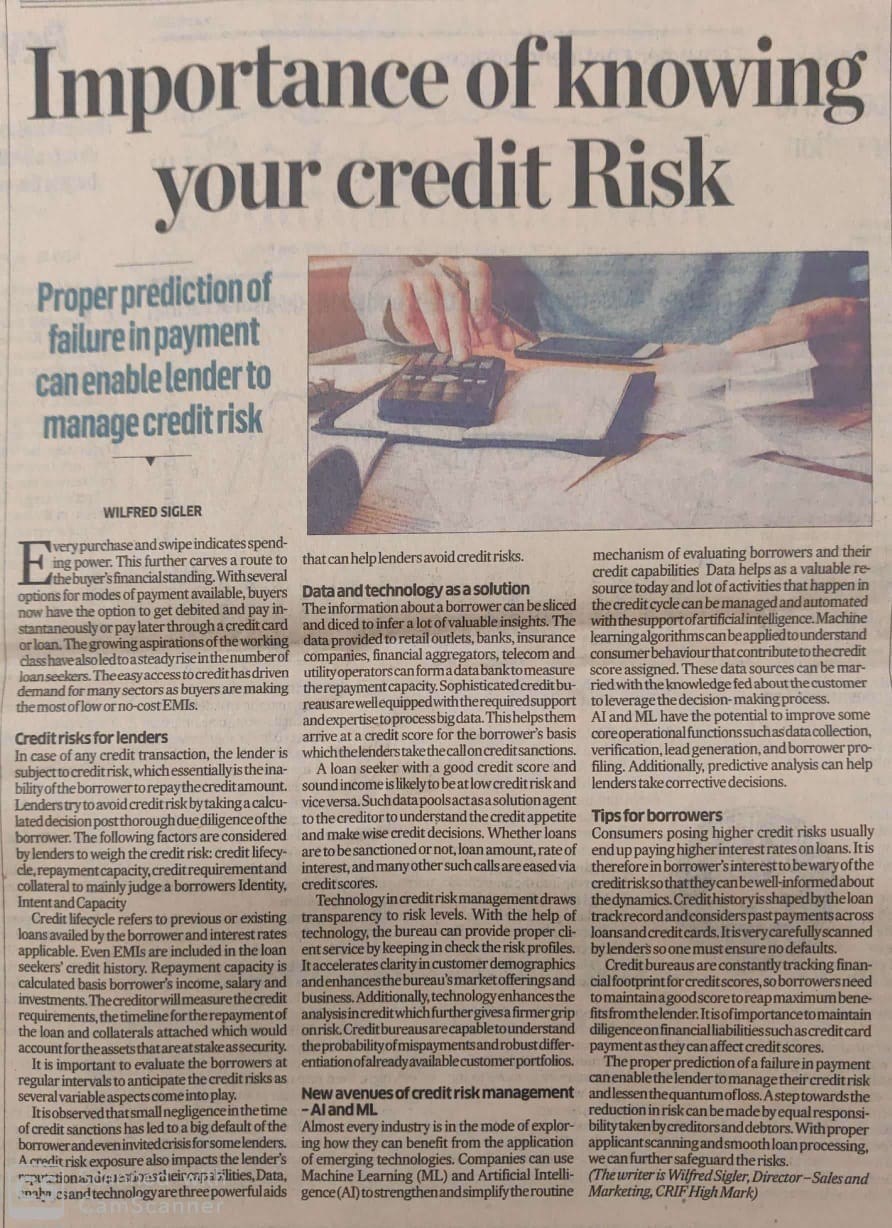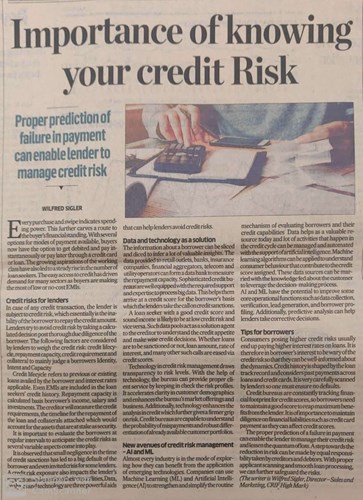Importance of Knowing Your Credit Risk - Authored Article by Wilfred Sigler
Every purchase and swipe indicate a spending power. This further carves a route to buyer’s financial standing. With several options for modes of payment available, buyers now have the option to get debited and pay instantaneously or pay later through a credit card or loan. The growing aspirations of the working class has also led to a steady rise in the number of loan seekers. The easy access to credit has driven demand for many sectors as buyers are making the most of low or no cost EMIs.
Credit Risks for lenders
In case of any credit transaction, the lender is subject to credit risk, which essentially is the inability of the borrower to repay the credit amount. Lenders try to avoid credit risk by taking a calculated decision post thorough due diligence of the borrower. The following factors are considered by lenders to weigh the credit risk: credit lifecycle, repayment capacity, credit requirement and collateral to mainly judge a borrowers Identity, Intent and Capacity
Credit lifecycle refers to previous or existing loans availed by the borrower and interest rates applicable. Even EMIs are included in the loan seekers credit history. Repayment capacity is calculated basis borrower’s income, salary and investments. The creditor will measure the credit requirements, timeline for the repayment of the loan and collaterals attached which would account to the assets that are at stake as security. It is important to evaluate the borrowers at regular intervals to anticipate the credit risks as several variable aspects come into play.
It is observed that a small negligence in the time of credit sanctions has led to a big default of the borrower and even invited crisis for some lenders. A credit risk exposure also impacts the lender’s reputation and questions their capabilities, Data, analytics and technology are three powerful aids that can help lenders avoid credit risks.
Data and technology as a solution
The information about a borrower can be sliced and diced to infer a lot of valuable insights. The data provided to retail outlets, banks, insurance company, financial aggregators, telecom and utility operators can form a data bank to measure the repayment capacity. Sophisticated credit bureaus are well equipped with the required support and expertise to process big data. This helps them arrive at a credit score for the borrower’s basis which the lenders take the call on credit sanctions.
A loan seeker with a good credit score and sound income is likely to be at a low credit risk and vice versa. Such data pools act as a solution agent to the creditor to understand the credit appetite and make wise credit decisions. Whether loans are to be sanctioned or not, loan amount, rate of interest, and many other such calls are eased via credit scores.
Technology in credit risk management draws transparency to risk levels. With the help of technology, the bureau can provide proper client service by keeping in check the risk profiles. It accelerates clarity in customer demographics and enhances the bureau’s market offerings and business. Additionally, technology enhances the analysis in credit which further gives a firmer grip on risk. Credit bureaus are capable to understand probability of miss payments, provide quick decision making to the client, and robust differentiation of already available customer portfolios.
New avenues of credit risk management – AI and ML
Almost every industry is in the mode of exploring how they can benefit by the application of emerging technologies. Companies can use Machine Learning (ML) and Artificial Intelligence (AI) to strengthen and simplify the routine mechanism of evaluating borrowers and their credit capabilities Data helps as a valuable resource today and lot of activities that happen in the credit cycle can be managed and automated with the support of artificial intelligence. Machine learning algorithms can be applied to understand the consumer behaviour that contribute to the credit score assigned. These data sources which can be married with the knowledge fed about the customer to leverage the decision- making process.
AI and ML has the potential to improve some core operational functions such as data collection, verification, lead generation and borrower profiling. Additionally, predictive analysis can help lenders take corrective decisions. AI and ML has the potential to bridge the gap for the future of automated, safe and secured ecosystem.
Tips for borrowers
Consumers posing higher credit risks usually end up paying higher interest rates on loans. It is therefore in borrower’s interest to be wary of the credit risk so that they can be well-informed about the dynamics. A credit history is shaped by the loan track record and considers past payments across loans and credit cards. It is very carefully scanned by lenders so one must ensure no defaults.
Credit bureaus are constantly tracking financial footprint for credit scores, so borrowers need to maintain a good score to reap maximum benefits from the lender. It is of utmost importance to maintain diligence on financial liabilities such as credit card payment, EMI repayments etc. as they can affect credit scores.
The proper prediction of a failure in payment can enable the lender to manage their credit risk and lessen the quantum of loss. A step towards reduction in risk can be made by equal responsibility taken by creditor and debtor. With proper applicant scanning and smooth loan processing we can further safeguard the risks. Such a credit risk management will pave the way for an efficient and safe credit environment.
Source: Publication: Deccan Herald, Page No-09| 10th Feb 2020

